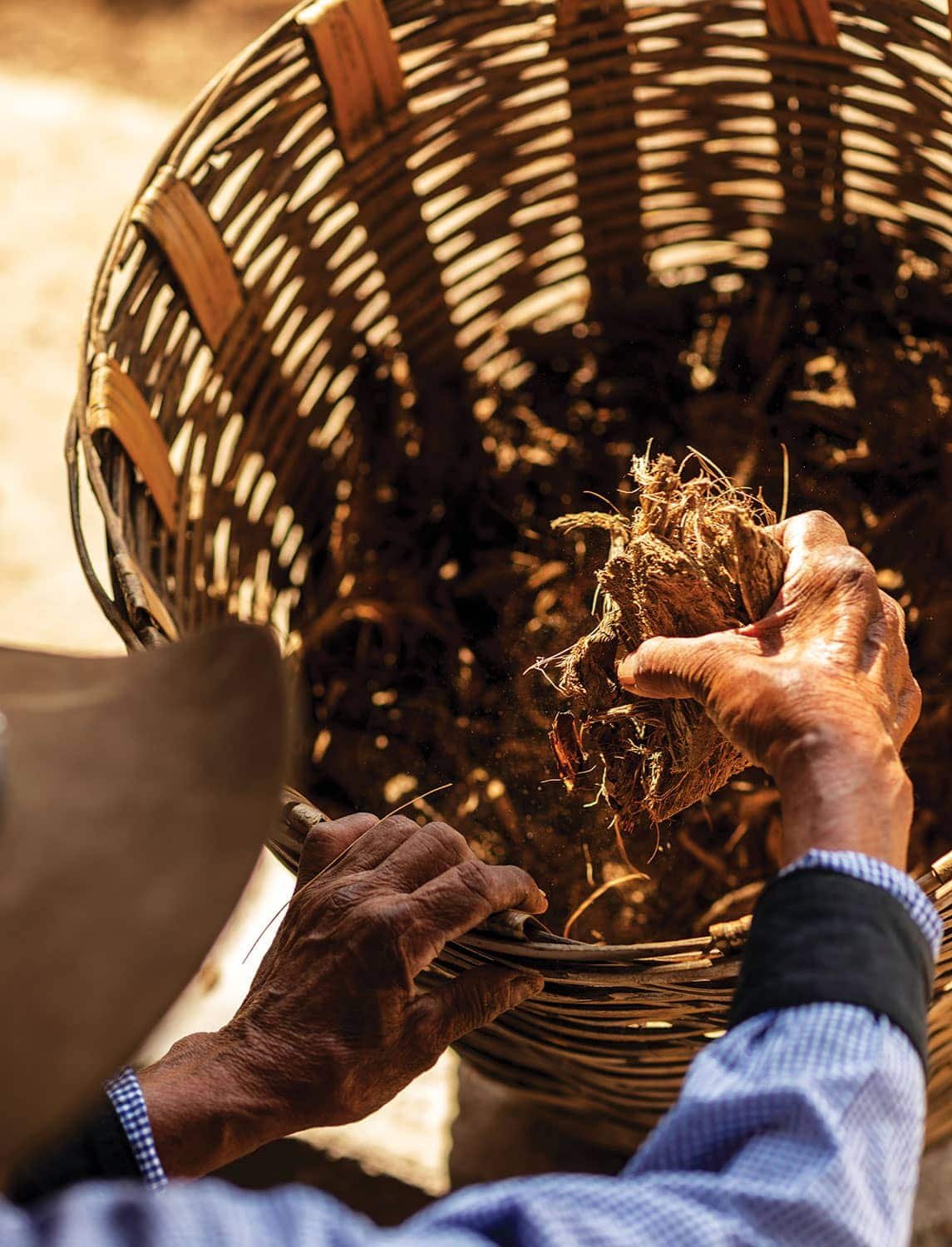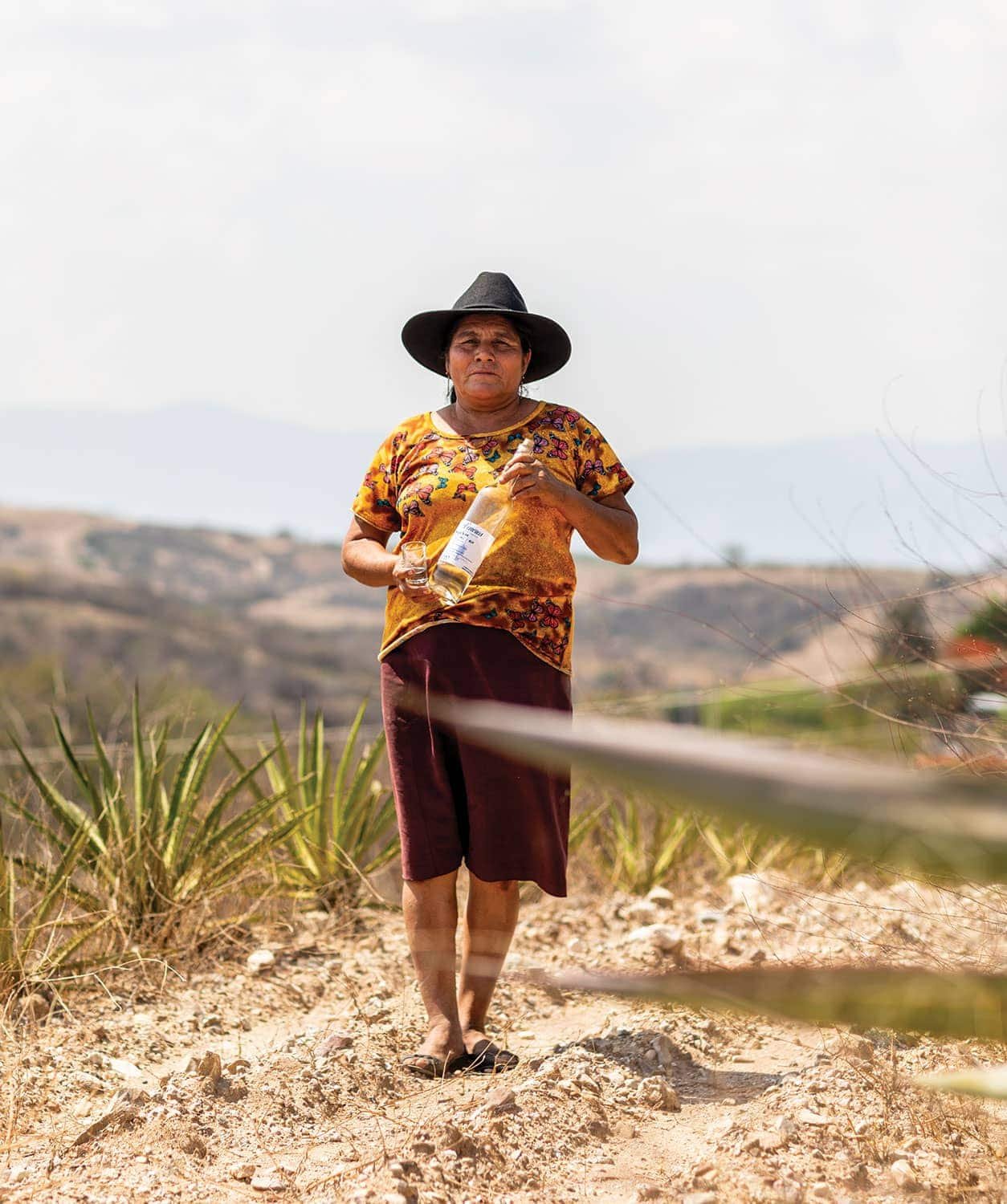TÍO TELLO
Eleuterio Perez Ramos, or “Tío Tello’’ as he’s known among the small community of El Nanche in Oaxaca’s Miahuatlán region, scrambles to cover his freshly roasted agaves. A rare, spring hailstorm has settled over his newly built palenque (mezcal distillery). Tío Tello roasts agave only a few times a year, and almost always in the dry season. Small batches can mean higher risk when you’re making, at most, 2,000 liters of mezcal a year. Any loss is deeply felt, and waterlogged agaves pose specific challenges requiring years of experience to overcome.
Tío Tello’s a little over 70 and sometimes walks with a cane, but he moves quickly when the safety of his agave is at stake. He gathers a mix of bamboo mats and plastic sheets, to protect them from the hail. These agaves took between 10 and 20 years to mature—they could be ruined in an instant.
His youngest son, Eduardo “Lalo” Perez Cortés, works in tandem, doing more of the heavy lifting, moving the agaves to safer shelter while directing two neighbors who are here to pitch in. At 32, Lalo’s the youngest of Tío Tello’s eight sons, deeply tanned and baby-faced, with a bright smile and a compact, strong frame. Some mezcaleros tend to have a quiet, wiry strength from constant manual labor—chopping and mashing agaves by hand is among the hardest work around.
EDUARDO “LALO” PEREZ CORTÉS
Tío Tello and Lalo work with an easy yet practiced rhythm. Lalo’s worked under his father’s tutelage since he was a toddler. Lalo studied accounting in school, but returned to El Nanche to work with his father, and now lives with his wife and two children within sight of their new palenque. It was finished in late 2022, but Tío Tello has been working this rugged piece of land for more than 30 years.
Miahuatlán is a little over two hours’ drive southwest of Oaxaca City, at the edge of the central Oaxacan valley along the Sierra Madre del Sur. Past low, rolling hills and endless variations of brown scrub punctuated by neatly planted fields of agave, down the road from the massive federal prison outside the town of Mengoli de Morelos, sits El Nanche.
Mezcal lovers will tell you that this unforgiving corner of the valley is where the best mezcal in Oaxaca, potentially even in all of Mexico, is made. Spirits produced in pristine environments are frequently romanticized, but the harshness of Miahuatlán seems to provoke a certain intensity of the spirit. High-toned, mineral-forward, and with a marked salinity, these mezcals are unmistakably of Miahuatlán. It could be the terroir, the astonishing biodiversity of agaves, or the technical precision of the region’s producers, but another answer seems simpler: There’s immense value in the generational knowledge passed down in close-knit, extended families of mezcaleros.
OAXACA’S MIAHUATLÁN REGION.
Mezcal’s soaring global popularity has complicated an already complex generational handoff within Oaxaca’s rural communities. These families need to cope with the past while preparing for their future. Yet there’s only so much planning a family can do to secure their legacy. Ultimately, the next generation has many questions to resolve. Do they maintain the family “recipe”? With many of these families so rooted in tradition, even minor changes are magnified. Do they modernize and chase what could be elusive money through multinational liquor conglomerates? These days, opportunities exist in even the most remote parts of Mexico.
Tío Tello recalls that when he was 11 or 12, he started helping his own father by doing small errands. “I brought lunch and dinner at first, but then I would stay and keep him company,” he says. “Since that time, I’ve dedicated myself to the work of mezcal.” Lalo learned along the same path. By the time Lalo could walk, he was watching his father and grandfather make mezcal. The manual labor is essentially the same across generations: processing agaves by hand, scooping the bagasse—roasted and fermented agave fibers—from the wooden tanks into the still.
As a young man, Tío Tello and his family mostly worked with arroqueño agaves, sort of a super-charged espadín, along with bicuixe, a narrow karwinskii subspecies that looks like a giant matchstick once trimmed. The initial wave of modernization started in the 1970s with the introduction of new agave varietals from other parts of Mexico. Arroqueños take more than twice as long to mature as the sweeter and faster-growing espadín. Much of the old agaves were made into mezcal and then not replanted. The rustic field blends of Tío Tello’s youth, using whatever ripe agaves could be harvested at a particular moment, faded away as espadín began to dominate.
“The fermentation will talk to you. I sniff the tank every hour and have to make sure I don’t miss the perfect moment,” says Tío Tello. “It asks for water or tells you when it’s ready for the still. You have to listen.” Unsurprisingly, Lalo’s style is similar to his father’s, but he’s made some small adjustments, especially in how he blends his “cuts,” the crucial separations between the heads, hearts, and tails of the distillation. Together they continuously refine their blending techniques over each new batch of mezcal.
The new palenque promises a smooth handoff and a future for Lalo and his children, but “new” here is still relative. Three worn, wooden fermentation vats sit in the shade under a curved, corrugated metal roof. There’s no electricity or instrumentation, just a few open bulbs for late-night checking of the stills. The hail continues, but under the safety of the roof, Tío Tello’s neighbors continue processing the agaves by hand in a practiced dance—one shaving off chips of roasted agave with a machete, while the other smashes the pieces to bits with an old wooden mallet.
At the end of the day, Tío Tello has taught his son to embrace the rhythms of the palenque. The most important things he hopes to impart to his son, he says, are “preparation, organization, and punctuality.” These sometimes feel like totems of a bygone bucolic era, but this is the only way Lalo knows. “We’re making good, rico [tasty] mezcal that people like,” says Lalo. “We don’t need to change anything.
Logoche is a small community of a little over 100 people not far from El Nanche in Miahuatlán. The village is rightfully famous for its concentration of mezcal production, with many producers belonging to the Grupo Productor Logoche cooperative. There’s an openness to mezcal production here—possibly the result of everyone working together on a few palenques until very recently—and many producers are experimenting with technology alongside traditional practices.
Paula Aquino Sanchez is a dominating presence at her family’s palenque. She and her husband, Hermogenes, have recently become well-known mezcal producers in the United States. Their mezcal, bottled as part of the Neta label, sells for up to $200 a bottle. Likewise, Sanchez commands an unusual level of respect in a country and region where traditional, rigid gender hierarchies are omnipresent. She often takes the lead on mezcal production, but is now in a position where she can pick and choose how she contributes. She’ll occasionally make a batch herself, like the cuixe she pours, laden with so much rich, cooked agave flavor it tastes of maple syrup. Still, she makes the smallest batches among her family because “I’m always in the kitchen,” she says.
Despite that, her presence is inseparable from the palenque. While her husband and youngest son, Jorge, weigh massive, freshly harvested espadín agaves at more than 250 kilos each, Sanchez tours around her family’s agave fields, pointing out medicinal herbs and other rare plants. Paula and Hermogenes have three sons and a daughter. They all work together at the palenque and she recalls how, “after school, I would say to my children, ‘Today is the day we learn distilling, or today we learn fermentation,’ and I would make them do that exact activity.”
AGAVE HEARTS.
Balancing a traditional matriarch’s duties on a farm in Mexico alongside making mezcal is a lifestyle few people (even those in her community) can understand. Sanchez’s path was nontraditional and born from necessity. She has few memories of her father, who also made mezcal and died when she was 6 years old. Alongside her older brother Eugenio, who has since also passed away, she was making mezcal at a very young age, primarily as a breadwinner for her impoverished family. Like Lalo, she initially helped by bringing food to the older men working on the palenque—her grandfather, uncles, and older brother—but she was doing the difficult, manual labor at a much younger age. There were only a handful of palenques in Logoche at the time, so everyone worked closely together, sharing knowledge and techniques.
While her grandfather was the strongest presence in teaching her the art of mezcal production, she considers her late brother her mentor. Like Tío Tello, they were taught by the CRM to double distill mezcal in the 2000s. Sanchez says she prefers the double-distilled mezcal because the old style “gave me headaches,” and is proud of the technical precision she honed in distilling alongside her late brother.“We notate everything now, and I can see that it yields more. We make fewer errors and are always improving.”
Here, they use a modified wood shredder to process agaves. A new, unused tahona sits in one corner of the palenque. While her father and grandfather worked with a tahona, they switched to save time and labor. Now, their youngest son, Jorge, is advocating for the tahona, and they plan to return to the practice soon.
The blending of the old and the new is apparent everywhere in Logoche, but especially through Sanchez. She’s shrewd—over the past decade, making mezcal has given her and her children opportunities that would have been unfathomable even a decade ago—but she still must work within the traditional Mexican patriarchy, balancing all of the work of home and family alongside the grueling labor of making mezcal.
Sanchez respects what she learned from her grandfather and brother, but her focus is forward. She’s proud of her family’s mezcal, but sees room for improvement and refinement. Even with all of the changes she’s witnessed, the traditional culture surrounding mezcal remains.
https://imbibemagazine.com/the-mezcal-families-oaxaca-mexico/








